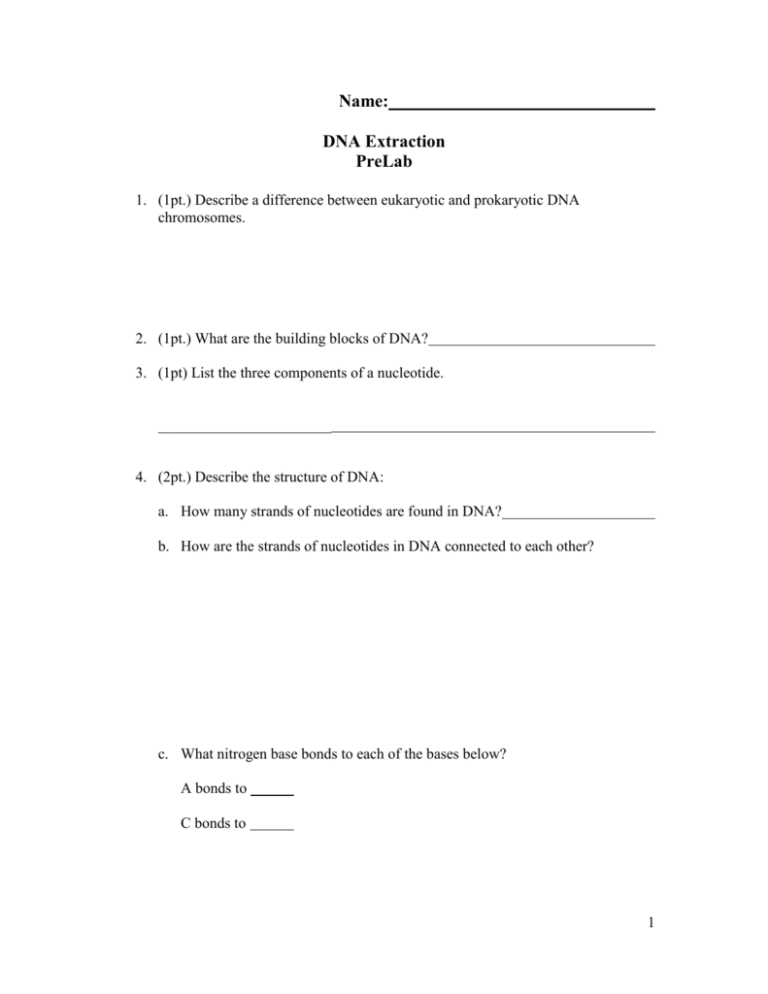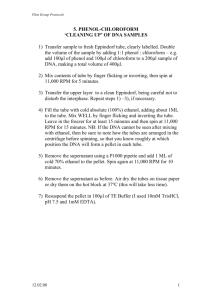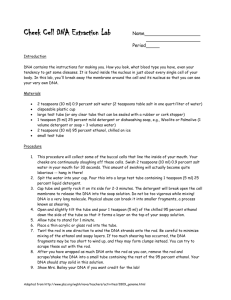DNA Extraction
advertisement

Name: DNA Extraction PreLab 1. (1pt.) Describe a difference between eukaryotic and prokaryotic DNA chromosomes. 2. (1pt.) What are the building blocks of DNA? 3. (1pt) List the three components of a nucleotide. _______________________ 4. (2pt.) Describe the structure of DNA: a. How many strands of nucleotides are found in DNA? b. How are the strands of nucleotides in DNA connected to each other? c. What nitrogen base bonds to each of the bases below? A bonds to C bonds to 1 2 Lab Exercise DNA Extraction 11/18/14 DNA in all organisms is found primarily in chromosomes. Eukaryotic cells, like those found in humans, contain several linear chromosomes. Prokaryotic cells, such as bacteria, contain one large circular chromosome. DNA is composed of building blocks called nucleotides, each made up of a fivecarbon sugar (deoxyribose), a phosphate group, and a nitrogenous base. The four kinds of nucleotides differ only in their nitrogenous bases. It is the nucleotides and their bonding pattern that give DNA its unique characteristics and functions. Structurally, DNA contains two long strands of bonded nucleotides. These strands run in opposite directions. The two long strands are connected by hydrogen bonding between the nitrogen bases of the nucleotides (A-T and C-G). Each bonded pair of nucleotides is called a base pair. An average gene consists of a sequence of approximately 3000 base pairs. The functional units of DNA, the genes, code for polypeptides which serve countless functions for the cell. Without proteins (for example, enzymes), the chemical reactions that make up a cell’s metabolism could not proceed in a timely manner, and the cell would die. Bacterial chromosomes contain approximately 3000 genes. Humans, on the other hand, contain about 20,000-25,000 genes in each of their cells. If all of the DNA in all of the cells of a human were stretched end to end, it would form a ladder 100 billion kilometers (you could climb to the sun and back 300 times). Today, you will extract DNA from the bacterium Micrococcus luteus. The first step is to lyse (burst) the M. luteus cells to release the DNA into the solution. In order to do this, a detergent used in laundry products called SDS (sodium dodecyl sulfate) is used to degrade lipids in the bacterial cell membrane. When the cell membrane is damaged, the cell lyses, releasing the cytoplasm’s contents into the solution. This causes the solution to become viscous (thick) due to the long strands of DNA that are no longer as tightly coiled as they were in the cell. Along with DNA, enzymes and other proteins are released. Because enzymes harmful to free DNA must be destroyed, the solution is heated (proteins denature or lose their functional shape at 60-650C). DNA also denatures when heated but only when the temperature reaches 800C. Cold ethanol, an alcohol, will then be added. DNA is insoluble in alcohol and will precipitate (come out of solution) when it comes in contact with ethanol. A spooling rod is used to remove the DNA. By slowly rotating the rod in the solution, the DNA will attach and coil around it. Because DNA is long and thin, it can be mechanically broken quite easily. Be extremely gentle at all time. 3 Materials: per group of 4 1 tube of freeze dried M. luteus bacterial suspension solution (share bottle with other groups) SDS (sodium dodecyl sulfate) 1ml pipet and pipet pump two 5ml pipet and pipet pump 1 spooling rod (glass rod) 1 large test tube containing 20ml of 95% ethanol, refrigerated test tube rack hot water bath (60-650 C) Procedure: 1. 2. 3. 4. 5. 6. 7. 8. 9. 10. Pipet 5ml bacterial suspension medium into the test tube containing freezedried M. luteus Gently rotate the test tube between your palms for approximately 5 minutes until the bacteria go into suspension. Pipet 1ml SDS into the suspension. Again gently rotate the tube between your palms several times over a 5 minute period. Place the tube in a 60-650C water bath for 30 minutes. After 30 minutes in the water bath, remove tube and allow to cool to room temperature. Carefully lower the spooling rod (glass rod) into the tube. Tip tube at 450 angle. Keep holding the tube at this angle until step 10. Have a lab partner pipet 5ml of cold ethanol into the tube. Hold the pipet against the inside wall of the tube (still tipped at 450 angle) and allow the ethanol to flow very slowly down the side of the tube onto the top of the M. luteus solution. Do not shake the tube. Slowly rotate the spooling rod in a continuous clockwise motion while continuing to hold the tube at an angle. Avoid touching the sides of the tube. Fibers of DNA will come out of solution and attach to the glass rod like thread on a spool. Continue rotating the rod for several minutes until a mass of DNA is attached. 11. Remove the glass rod and gently immerse it in the tube containing the remaining ethanol for 10 minutes. 4 Name: DNA Extraction Lab Report 1. (1pt) What is a ‘base pair’? 2. (0.5pt.) On average, how many genes are in a bacterial chromosome? 3. (1pt) In the experiment you will add the detergent SDS to the bacterial cells. What is the purpose of adding SDS?_________________________________________________ ________________________________________________________________________ ________________________________________________________________________ 4. (1pt) When extracting DNA, how do you remove the effects of harmful enzymes that degrade DNA?___________________________________________________________ ________________________________________________________________________ 5. (1pt) What is the purpose of using ethanol is the experiment?_____________________ ________________________________________________________________________ 6. (0.5pt) Describe the appearance of the extracted DNA on the spooling rod. ._______________________________________________________________________ ________________________________________________________________________ ________________________________________________________________________ 5








